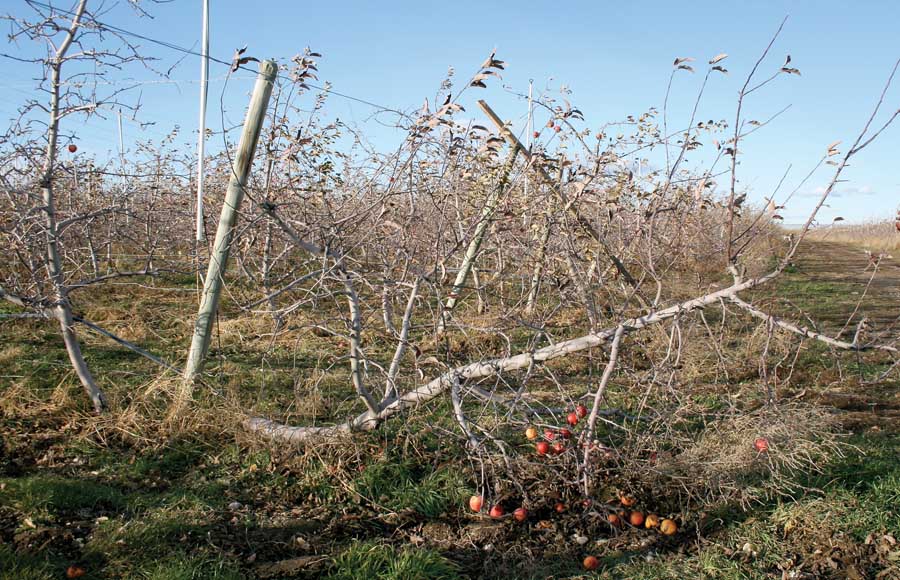
An example of a trellis system that failed to support an organic apple orchard row in central Washington. (Geraldine Warner/Good Fruit Grower file photo)
As the tree fruit industry grows increasingly more progressive with high-density plantings, growers are left wondering how to design the perfect trellis that won’t fail under heavier crop loads.
There’s no engineering guidebook that answers all of their potential questions — and there are many. What incline is recommended for an angled trellis system in my growing conditions? What system and materials are best suited for my soil type? How much distance should I leave between posts?
A new research project supported by the Washington Tree Fruit Research Commission aims to answer some of those questions, with a goal of producing an engineering guide for trellis installation that takes into account fruit loads in high-density plantings and fixed and variable loads on a system.
“The reality is that if you were going to put up a laundry line and you were just going to hang your clothes, your needs are very different than if you were going to hang your clothes and your neighbor’s clothes and rugs,” said Mark De Kleine of De Kleine Machine Co., lead researcher on the study.
“The trellis system is the foundation of the orchard,” he said. “When you lose a trellis system, it can be devastating. In some cases, you can salvage trees, and in some cases, it’s a complete failure and you have to start over. You don’t ever want to be in that situation.”
Too many growers have looked to a neighbor for ideas, he said, “but you don’t really have an idea what that system looks like if you’re going to grow 80 bins to the acre, 150 bins to the acre or 200 bins to the acre. And there’s no real sense, as a grower who’s going to put in a trellis system, how to design a system for my conditions, my soil type, my horticultural practices.”
Preliminary results
For the first phase of the project, researchers surveyed growers about trellis failures in Washington. Thirteen failures were reported. Crop loads ranged from 40 bins per acre to 130 bins per acre.
Half of all failures occurred in September and October, when crop loads were heaviest, and in some cases, several feet of crop was growing above the top wire of the trellis. Failures were evenly split between angled and vertical systems.
What most stood out in the responses — and what was most surprising — was that 90 percent of the failures occurred within the first 10 years, De Kleine said. “You can look back and say, in the last decade, there’s been lots of changes in trellising, and crop loads are increasing, but to have a failure in the first 10 years is surprising,” he said.
Sixty percent were related to in-row posts snapping or being upended. In-row post spacing ranged from 40 feet to 55 feet, but in more than half, spacing was greater than 40 feet.
Roughly 40 percent of the failures were related to anchor or anchor-wire failures, including loose anchors and rusted anchor wires. High wind events were reported in 40 percent. One failure occurred after a 20-hour watering interval in sandy to sandy-loam soil.
Final project
The researchers aim to build a user interface in which growers could enter variables from their orchard, such as soil type, trellis type and projected crop load, to determine the type of installation needed to support that crop load.
In building the interface, they are taking into account various loads applied to the system, including wind, installation of any additional superstructure such as netting, and any loads that could come from automation, such as machine pruning or harvest. The final interface should enable growers to add variables as necessary to determine the ideal trellis for their orchard system, De Kleine said.
Other researchers on the project: Karen Lewis, Washington State University tree fruit regional extension specialist, Paul Booker of Century Steep in Othello, Washington, and Chuck Pezeshki of WSU’s Mechanical Engineering Department. •
– by Shannon Dininny
Trellis inspecting tips
Researchers offered a few tips for inspecting trellises for security:
—In-row wires should not have kinks, and breaks need to be repaired.
—Look for in-row posts that have become loose or are leaning beyond the intended angle, as well as bowing wood posts or, if applicable, bending at wire notches on metal posts.
—Check anchor wires for rust and breaks. Is the eyelet below ground, exposed to the soil environment?
—Ensure that anchors have not become loose.
To read more about the survey results, visit www.surveymonkey.com/r/DeKeineTrellisWTFRC.






Leave A Comment